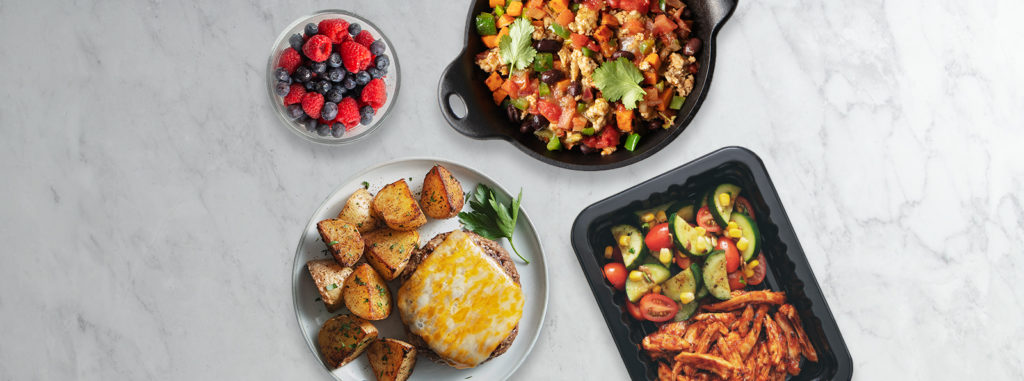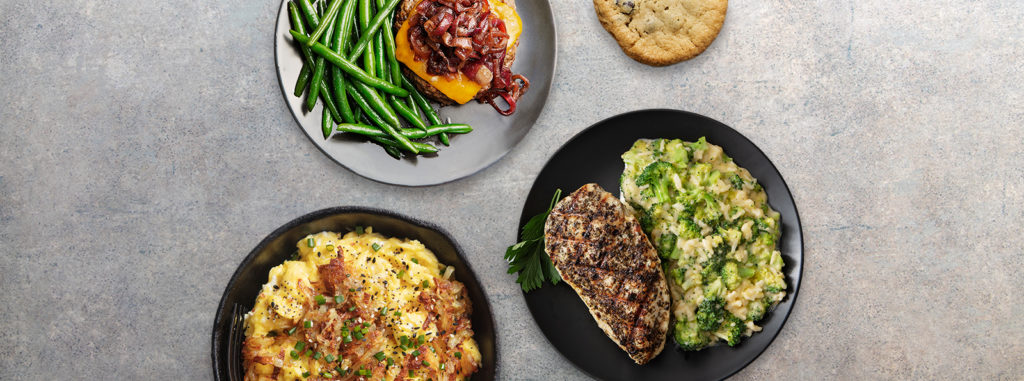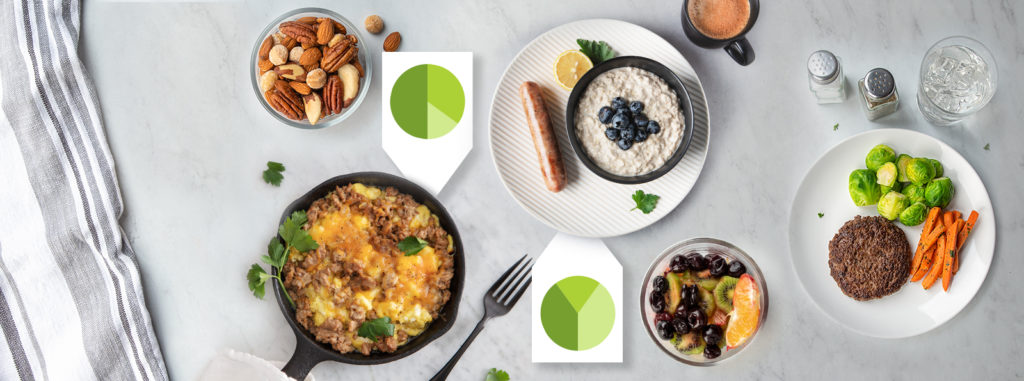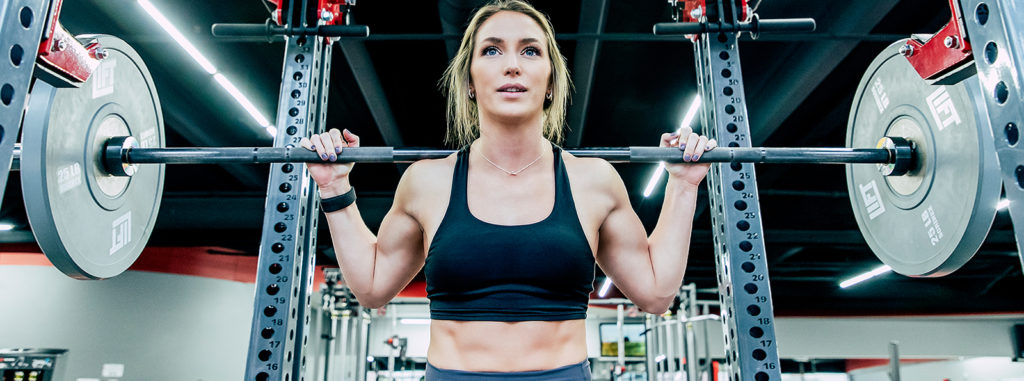ARTICLE AT-A-GLANCE
What is Carb Cycling?
Carb cycling refers to the practice of alternating carbohydrate intake on a regular cycle, sometimes daily. Carb cycling has long been utilized by athletes who have to balance performance with physique goals. It’s an approach that allows fat loss while maintaining muscle mass and performance.
As another benefit, carb cycling is a way to experience some of the benefits of a low carb diet while not having to avoid your favorite healthy high-carb foods indefinitely. If done correctly, carb cycling can be the best of both worlds.
What are the benefits of carb cycling for women?
Women are ideal candidates for carb cycling for a few reasons.
First of all, many women struggle to lose extra body fat. With carb cycling, women can achieve a calorie deficit on their low-carb days without burning out on eating low carb.

With carb cycling, there’s always a high-carb day on the horizon. On these low-carb days, blood sugar stays low and cravings are minimal. These days also help to optimize insulin sensitivity. When women time these low carb days with the correct phase of their menstrual cycle, they can really optimize the success and sustainability of their fat loss efforts.
Another great thing about carb cycling for women is that the high-carb days help to grow and maintain muscle mass. This muscle mass increases our insulin sensitivity, reducing risk of type 2 diabetes. This muscle mass also increases metabolism which further supports weight loss efforts.

Those high-carb days also support our weight loss efforts in another way: by regulating our cravings. Healthy carbs have been shown to release leptin, a hormone that signals to your body that you’re full. With healthy carbs, women can hit a great workout and stay in control of energy intake with cravings at bay.
Another benefit of high-carb days for women is that it allows them to achieve their best performance in high-intensity training. Although low and moderate-intensity exercise can be performed equally well on any carbohydrate level, high-intensity exercise performance has been shown to be optimal on high carbohydrate intake.
So, what days should women plan to eat moderate vs. low carb? There are certain phases of the menstrual cycle (weeks 2 and 3) when women have higher estrogen and are best able to utilize carbohydrate.
During these weeks, insulin is higher and carbohydrates will go more toward muscle building and performance rather than toward fat storage. Thus, women can time high-carb days around the correct days of their menstrual cycle in order to fully optimize their muscle-building and performance benefits.
A final benefit of carb cycling for women is that it prevents over-restriction. With carb cycling, no foods are forever off-limits. Having less long-term restriction can help to avoid craving and bingeing. Carb cycling also has built-in flexibility. It can fit into any lifestyle.
What does the menstrual cycle have to do with carbs?
Whether we like it or not the menstrual cycle is your body’s way of preparing for a baby. Thus, your body is highly sensitive to changes in energy and carbohydrate intake across the cycle. Too-low intake of energy and/or carbohydrate signals that it’s not time for a baby. This signal can result in harmful hormonal dysregulation.
Thus, energy is key for ovulation and healthy, balanced hormones. The body’s preferred source of energy is carbs, so if we don’t get an adequate amount of carbs, our body will go into survival mode.
When it comes to optimizing our carb cycling, the specific hormone that women should primarily focus on is estrogen. Estrogen is the primary fluctuating female hormone that drives changes in insulin sensitivity and carbohydrate tolerance.
Estrogen peaks twice during the menstrual cycle. These two peaks are when women can leverage high intake of healthy carbs to optimize performance and muscle building efforts. During this time, healthy carbs are used by women for building muscle and driving exercise performance. Studies also show that carbs help to reduce the inflammatory impact of high-intensity of exercise.
On the other hand, the times with relatively lower estrogen levels are optimal for low-carb days. These are phases where are body is more likely to store carbs as body fat. Women are also less insulin sensitive during this time, so carbs will be utilized less readily. By eating low-carb on these days we avoid unwanted weight gain.
Here’s where these phases fall during the menstrual cycle:
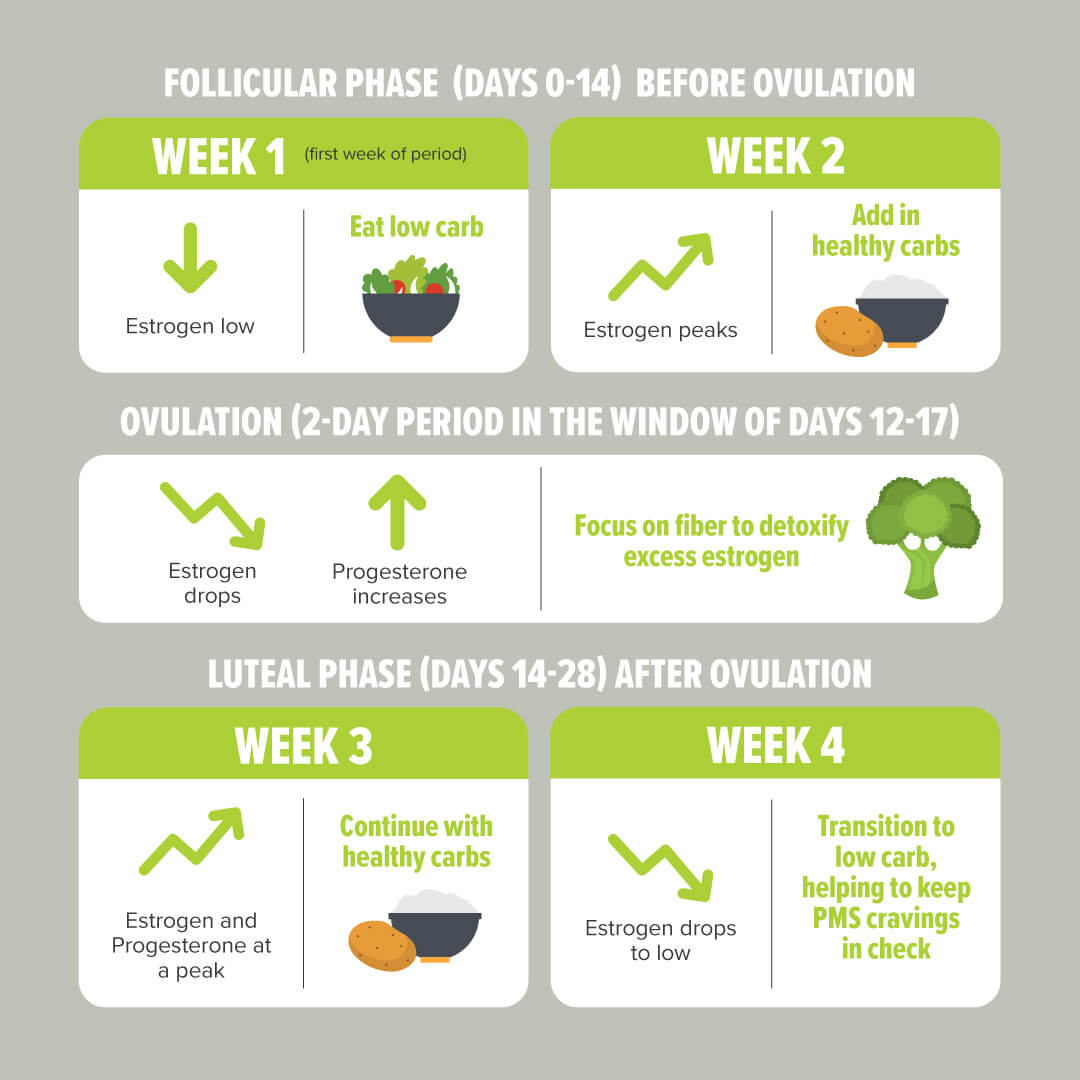
Follicular phase: Days 0-14, Before a woman ovulates, when hormones are beginning to “rev” up
Week 1 (first day of period is day 1): estrogen is still low so eat low-carb this week of your period.
More iron rich foods are needed during this week, which is perfect for a low carb diet. Some good iron sources include spinach, meat, poultry, oysters, and eggs.
Week 2 (from day 7-14 after first day of period): estrogen hits its peak this week.
Eat more healthy carbs this week. Always eat them with healthy fats and proteins so that blood sugar stays relatively stable. Focus them especially around your workouts. Examples include oats, potatoes, sweet potatoes, butternut squash, brown rice, quinoa, and fruit.
Ovulation (2-day period in the window of days 12-17)
Estrogen starts to drop as progesterone starts to climb.
Focus on fiber to bind and detoxify excess estrogen. Examples include vegetables, berries, whole grains, nuts, and seeds. Begin to transition down on carbs during these days.
Luteal phase (Days 14-28, between ovulation and period. Hormones peak the first half then drop in the second).
Week 3 (days 14-21 of cycle): estrogen and progesterone both climb to a peak.
Continue with healthy carbs as you did during week 2.
Week 4 (days 21-28): estrogen drops back to a low.
Transition back to low-carb this week. Yes, it’s PMS week. Keep cravings and symptoms under control with foods rich in B-vitamins (vegetables and meat), calcium (veg and dairy or dairy replacement), magnesium (nuts and seeds), and fiber (low-carb veggies, nuts, seeds, and berries).
Staying low-carb will help avoid large swings in blood glucose (this will help to minimize cravings). Silver lining: dark chocolate is low carb!
If I’m training, should I adjust my carb intake for my cycle?
Yes! You can’t change what your hormones are doing across the month but you can plan your diet and workouts accordingly.
I have my clients follow this protocol:
– Week before period and week of period: eat low-carb and prioritize low-intensity exercise such as yoga, jogging, and high-rep/low-weight strength training.
– After period for two weeks (middle 2 weeks of cycle): eat healthy carbs with each meal and with most snacks. Eat healthy fats and proteins with each meal (never eat carbs alone). Focus your carbs around your high-intensity workouts. Prioritize high-intensity exercise like sprints, high-intensity interval training (HIIT), and low-rep/high-weight strength training.
A few other things to emphasize include:
- Make sure you are eating healthy carbs on ‘carb days’. A carb day does not allow you to binge out of cookies, cake, and crackers. You must fuel your body with nutritious carbs for the fiber, phytonutrient, and low-insulin response they provide.
- Make sure you focus on your other macros as well. Get enough quality protein and the right amount of quality fat across each day.
- Training days – focus carbs before and after exercise. This optimizes performance and recovery. You can even do this on low-carb days (have your only carbs be before and after workouts and keep the amount relatively low). Shoot for at least 30g of carbs within 3 hours before workouts and within 30 minutes after.
- Rest days – these are ideal days for a low-carb approach: protein, fats, and non-starchy veggies. Feel free to throw in a low-carb day during your two-week ‘high carb’ period of each cycle if it’s a rest day.
Bottom-Line
Carb cycling is an excellent strategy for women who want to optimize their body composition while maintaining their exercise performance.
However, the typical approach of alternating almost daily doesn’t match with female hormone cycling. The ideal approach for women is to plan for 2-week cycles of high and low carb diet combined with appropriate workouts for each phase.
Each woman has a unique combination of cycle length, training routine, goals, and lifestyle. Thus, it’s optimal to work with a nutrition and exercise professional to create a personalized plan for carb cycling and training.
Free Download: Sample Carb Cycling Meal Plan
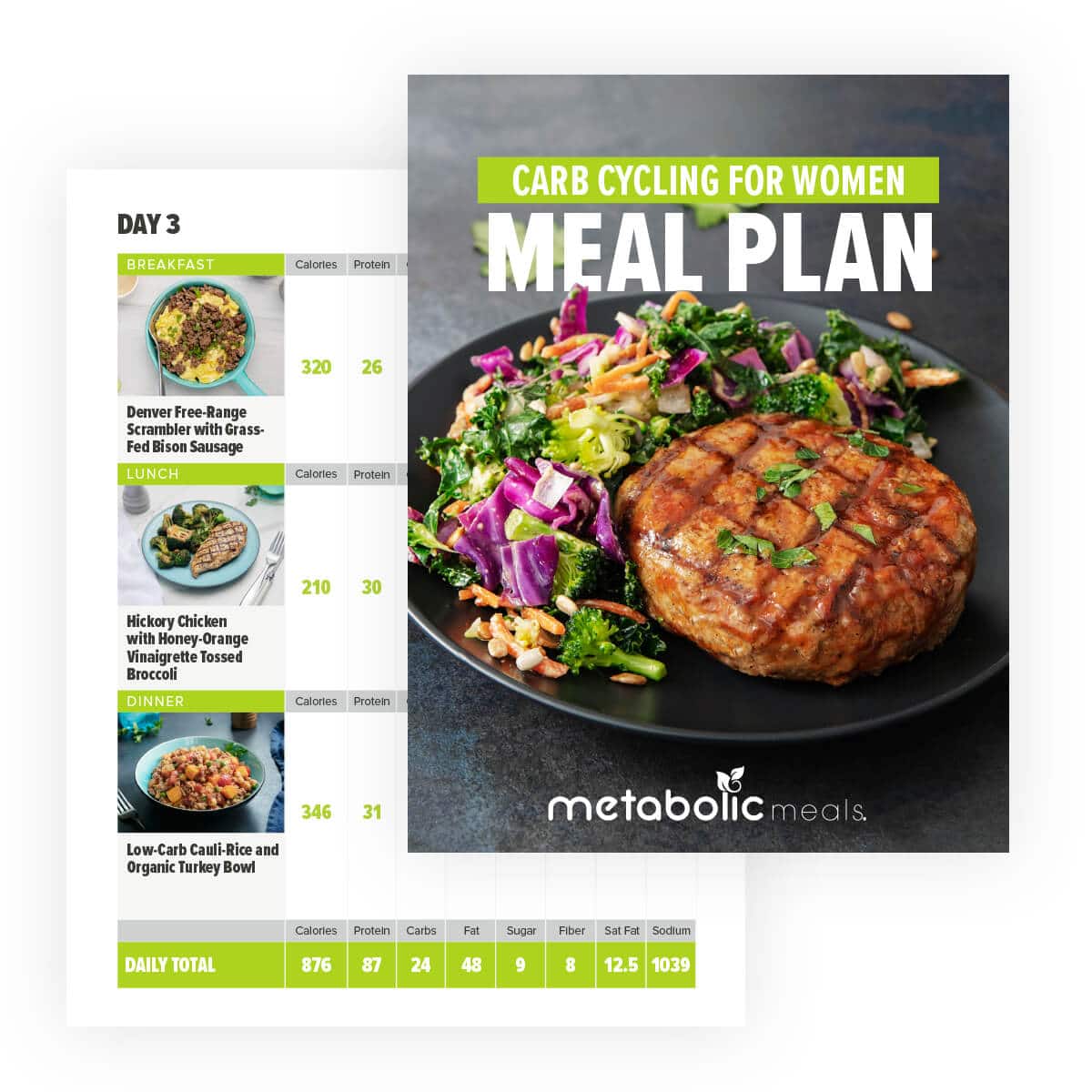 Our downloadable guide shows you how to build your own carb cycling meal plan, using chef-prepared, ready to eat meals from Metabolic Meals. Download Guide
Our downloadable guide shows you how to build your own carb cycling meal plan, using chef-prepared, ready to eat meals from Metabolic Meals. Download Guide
Erin Skinner is a Registered Dietitian Nutritionist who is board certified in Integrative and Functional Nutrition. She is the author of The Bone Broth Miracle Diet and the creator of the Empowered Nutrition Podcast. In her private practice, she specializes in helping women optimize their metabolic, digestive, and hormonal health. You can find more details about Erin’s podcast and practice at www.ErinSkinner.com.


